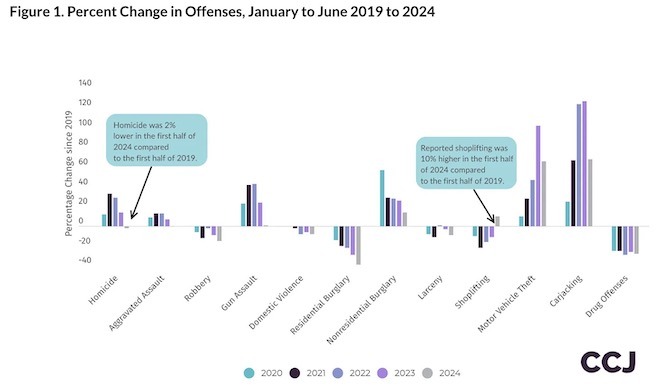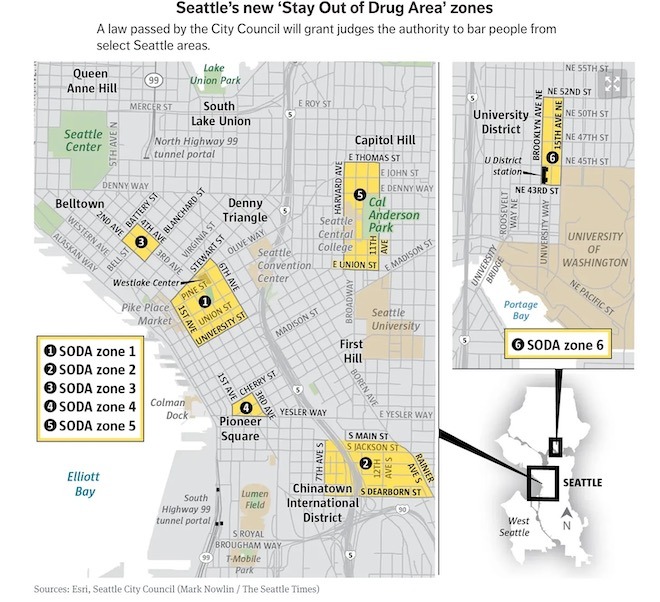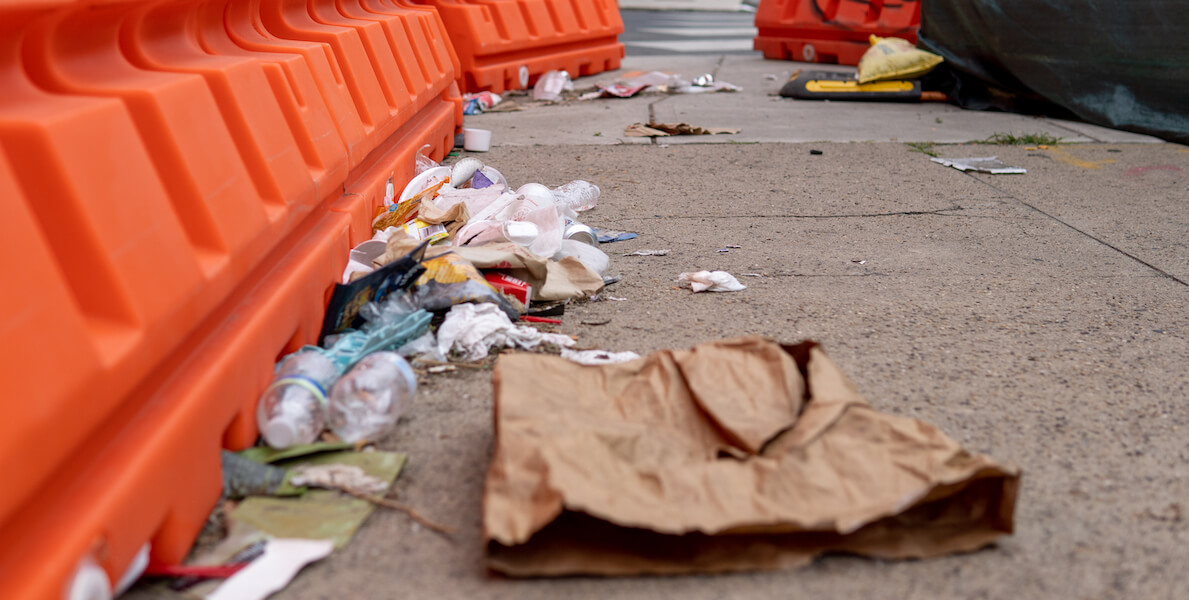Last month, Philadelphia notched the lowest homicide rate for the month of September since 2015. But the city also saw its number of homeless people rise to more than 5,000, an increase of 10 percent over last year, and the third consecutive year of increases.
These countervailing statistics represent, in a nutshell, the public safety and quality of life dilemma facing cities. Many American cities have lower violent crime rates than they did before the pandemic, but they also are grappling with higher rates of “disorder.”

Charles Fain Lehman notes in his recent article, “We need to talk about America’s disorder problem,” that despite a lower likelihood that city residents or visitors will experience crime, there is an increasing perception that cities are unsafe. Lehman blames this mismatch between data and perceptions on disorder.
Notably, disorder does not get reported as a crime, but it can nonetheless diminish the quality of life in a city. Disorder would be the drug-addicted person bent over on the street, the person who jumps a subway turnstile, trash piling up along curbs, the homelessness encampment. All these indicators add up and make cities less livable and seem less safe.
If this sounds a little like “broken windows theory,” that may not be a coincidence: Lehman is a fellow at Manhattan Institute where the theory’s co-founders, Julius Q. Wilson and George L. Kelling, were affiliated. At a time when cities need to attract and retain both residents and visitors, addressing disorder should be a paramount concern. But like all issues that touch public safety, the topic often turns into a culture wars issue.
Back to broken windows
The original broken windows theory contends there’s a snowball effect from small aspects of disorder — litter, rowdiness — first to an entire neighborhood’s loss of social norms, then to crime. Here’s some of the text from the original essay, published in The Atlantic in 1982:
We suggest that “untended” behavior also leads to the breakdown of community controls. A stable neighborhood of families who care for their homes, mind each other’s children, and confidently frown on unwanted intruders can change, in a few years or even a few months, to an inhospitable and frightening jungle. A piece of property is abandoned, weeds grow up, a window is smashed. Adults stop scolding rowdy children; the children, emboldened, become more rowdy. Families move out, unattached adults move in. Teenagers gather in front of the corner store. The merchant asks them to move; they refuse. Fights occur. Litter accumulates. People start drinking in front of the grocery; in time, an inebriate slumps to the sidewalk and is allowed to sleep it off. Pedestrians are approached by panhandlers.
At this point it is not inevitable that serious crime will flourish or violent attacks on strangers will occur. But many residents will think that crime, especially violent crime, is on the rise, and they will modify their behavior accordingly.
Broken windows theory contends that loosened social norms are to blame for disorderly cities. But Wilson and Kelling’s description of how community breaks down is naive — a piece of abandoned property is likely not the result of a willful lack of tending, but of job loss, environmental injustice, inadequate funding formulas for schools, or other factors that often lead to a neighborhood’s decline.
A piece of abandoned property is likely not the result of a willful lack of tending, but of job loss, environmental injustice, inadequate funding formulas for schools, or other factors that often lead to a neighborhood’s decline.
This insistence that disorder is caused by community breakdown and the questionable morals of elected officials continues through to authors like Lehman and Michael Shellenberger who wrote San Fransicko: Why Progressives Ruin Cities. Lehman still believes the solution to disorder is more social control:
To the extent that America does currently have a disorder problem, I suspect that it is downstream of a cascading failure of social control. This manifests, of course, in the systematic depolicing that took place in the wake of the murder of George Floyd/the defund the police movement. But it’s also downstream of COVID, which reduced social control in a variety of ways. COVID shuttered shelters, jails, and schools. It also reduced the number of “eyes on the street,” both in the short-run but also (thanks to the remote work exodus) over the long run. These two phenomena may be part of a broader failure of social control, as individual causes turn into a general reduction in the power of the institutions that govern our day-to-day lives, and stop disorder from creeping in.
Lehman is proposing that if we policed places more — whether formally or informally — we’d fix some of the tragic scenes of homelessness and drug use we come across in our cities. It’s a kind of conservative critique of progressive “soft on crime” approach. It’s true that many progressive leaders are reluctant to pour more money into police departments and are keen instead to address root causes of crime and disorder. As Kelling himself wrote, broken windows theory was meant to jolt people out of focusing on root causes of crime and instead on the more immediate concern about disorder.
But is it possible that it doesn’t matter whether you see disorder from a conservative or progressive stance, but whether your leaders craft good policies that actually deliver results?
Is disorder not a moral issue but a question of policymaking?
A good example of how it’s the policies, not the conservative or progressive approach, that matters can be seen in Seattle. (I hear more about disorder from my friends in Seattle than I do from friends in other places. I even know of people who moved across the country because they were so tired of it.)
Unfortunately, Seattle recently passed a bill to create Stay Out of Drug Areas, which will ban people who have previously been arrested for a drug crime from returning to a SODA zone and make it easier to re-arrest previous offenders. They also created Stay Out of Area of Prostitution zones (SOAP) with a similar idea in mind.

This seems highly bureaucratic, difficult to enforce, expensive for police, and like a time suck. But the worst part is that Seattle has tried — and failed — to improve disorder using a very similar approach before. This approach seems neither particularly progressive nor conservative — it’s centrist and bad.
It’s almost as if the city doesn’t know that Washington State has found a way to get people off the street and into housing, helping them address drug addiction — what a formerly homeless person called “life rehab.” Through encampment clearance, King County (which includes Seattle) has housed 90 percent of people formerly living in cleared encampments. As a Seattle Times piece on the program notes:
Whatever happens to the future of this new encampment removal model, Kelleher, the state housing policy director, said the program proved that addressing homelessness is a matter of desire.
“We know how to bring people inside,” Kelleher said. “People can argue about whether they want to do that or not, but they can’t say that we don’t know how.”
Getting beyond culture wars
We need to move beyond correlating disorder with lower standards for social norms and instead attribute disorder to poor policymaking. It’s not a breakdown in community, it’s a breakdown in leadership from the block level to City Hall, and often up to the state capitol.
Would the broken windows Wilson and Kelling wrote about have stayed broken if there had been a program like Philadelphia’s Whole Home Repair program that gives low-income homeowners small, forgivable loans to fix their homes?
Would there be trash on American streets if we followed our European counterparts who effectively containerize their trash and didn’t put waste transfer stations in poor neighborhoods where trash blows around?
Eliminating disorder requires leaders from public space, public safety, housing, and health to come together.
Would we be able to prevent more homelessness if more cities had eviction diversion programs and single-room occupancy dwellings?
I don’t want to sound like I’m oversimplifying here. And some issues, like drug addiction, are so complicated to address that there’s no one pithy example I can point to. But my broader point is that local leadership, perhaps more than intentions, matters.
If our local leaders don’t really know how to address disorder, I don’t think it’s their fault. Unlike many areas of urban policy — housing, transportation, environment — disorder transcends categorization. It requires leaders from public space, public safety, housing, and health to come together. I can think of few tables that are set to address this topic and share best practices, whether across a region or the world.
Look at two of the most exciting annual cities conferences happening this week: CityLab and Utopian Hours. Neither seems to have disorder on the agenda, despite the fact that most cities need an effective strategy on the issue.
A final thought
I started thinking about writing this post when I read that former New York Governor David Paterson and his stepson were assaulted on the Upper East Side while walking their dog one evening. The incident began because Paterson’s stepson (who happens to be the biological son of Curtis Sliwa, the founder of the Guardian Angels, the organization that teaches nonviolent crime prevention) told a group of teens who were climbing up a fire escape to come down or he was going to call the cops — it was a scenario that put “broken windows” in my mind. Later in the evening, Patterson and Sliwa ran into the teens again who were now joined by two adults who then beat up Patterson and Sliwa. The four attackers have subsequently been arrested and charged with gang assault.
As I saw photos and footage of the attack, I found my eyes drifting to the right side of the frame where trash containers form a barrier and recycling are piled on the side of the street. Here was New York City’s attempt to make trash collection cleaner, to ensure that heaps of trash bags on sidewalks weren’t encouraging crime like Wilson and Kelling thought they would.
This first attempt at containerization seems like not a complete success, but that doesn’t mean it’s not a step in the right direction. Figuring out how to address homelessness, public drug use, and other elements of disorder in cities may require some trial and error.
Diana Lind is a writer and urban policy specialist. This article was also published as part of her Substack newsletter, The New Urban Order. Sign up for the newsletter here.
![]()
MORE FROM THE NEW URBAN ORDER
Photo by Theo Wyss-Flamm.



